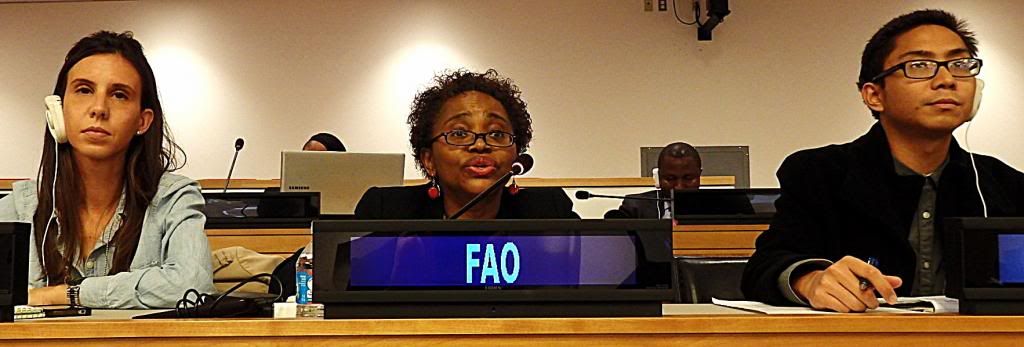General Debate, General Assembly's 2nd Committee
11/10/2013

Mr. Chairman,
At the outset, permit me to congratulate you and the members of the Bureau on your election, and to assure you of our support during the deliberations of the Committee. I am pleased to deliver this statement on behalf of the Rome-based Agencies, FAO, WFP and IFAD.
We start the work of the Second Committee with encouraging news, that , as indicated in the State of Food Insecurity, (SOF1) 2013, the proportion of undernourished people worldwide decreased in the past ten years as has the number of people experiencing chronic hunger. This proves that with political commitment, effective institutions, good policies, a comprehensive approach and adequate levels of investment, we can win the fight against hunger and poverty, a necessary first step to arrive at the other development milestones set by the MDGs.
Nevertheless and despite overall progress, food insecurity and malnutrition persist, with clearly marked differences across regions. Ninety-seven percent of the world’s under-nourished people live in developing countries. Sub-Saharan Africa remains the region with the highest prevalence of undernourishment, with modest progress in recent years. Western Asia shows no progress, while Southern Asia and Northern Africa show slow progress. In too many countries, and particularly in many middle income countries, undernourishment and undernutrition coexist, creating a double burden. Globally one-in-eight people are undernourished, lacking the means to regularly access sufficient food. Approximately one in four children under five – our next generation – are stunted impairing their physical and mental development. As a global community we must recognize the importance of providing nutrition-enhancing interventions particularly in the first 1000 days of a child’s life.
The role of women cannot be overstated. They represent 43 per cent of the agricultural work force worldwide and as much as 70 per cent in some countries. Often working longer hours than men, rural women are also the caregivers who look after children, the elderly, and the sick. In addition, many rural women are small business entrepreneurs and investors who dedicate most of their earnings to the well-being of their families and societies. The RBAs remain committed to the implementation of the program “Accelerating Progress Toward the Economic Empowerment of Rural Women” which is, as you may know, a five-year initiative of the UN Entity for Gender Equality and the Empowerment of Women (UN Women), the Food and Agriculture Organization of the UN (FAO), the International Fund for Agricultural Development (IFAD), and the World Food Programme (WFP).
The 38th Session of the FAO Conference in June, 2013, adopted a resolution which was submitted to the Secretary-General of the United Nations with a view to having the General Assembly consider declaring the Year 2015 as the International Year of Soils. It similarly adopted a resolution regarding the declaration of the year 2016 as the International Year of Pulses. Considering the relevance that soils and pulses have to promote and achieve food security and nutrition for all, the RBAs hope that the Second Committee will review positively these proposed resolutions. I also take this opportunity to invite you to the observance of the World Food Day (WFD) which will be held at the UN on Friday 22 November 2013. The focus of World Food Day this year is “Sustainable Food Systems for Food Security and Nutrition”. Later the same day, the launch of the International Year of Family Farming 2014 will take place at the United Nations. The International Year of Family Farming highlights the crucial role that family agriculture plays in improving food security and nutrition, as well contributing to employment generation and poverty alleviation in both developed and developing countries.
The Committee on World Food Security (CFS), meeting this week 7 – 11 October, is discussing a range of issues including on the post-2015 development agenda. The CFS is an example of the stewardship needed in the coming years in view of its multi-stakeholder approach and can serve as a point of reference for the Zero Hunger Challenge. The CFS was preceded by a Ministerial Meeting on Food Prices, which showed that even though international prices have declined, they are still above historical levels. We have to remain vigilant to find lasting solutions to the problem of food price volatility.
As we accelerate our efforts to achieve the MDGs by 2015 and as we plan for the new agenda we have the unprecedented opportunity to eliminate hunger and malnutrition. By committing to sustained investment in agriculture and rural development as well as the five objectives of the Zero Hunger Challenge, we can build the next generation, boost economic growth and build a stronger more prosperous world.
At the Global Thematic Consultation on Hunger, Food Security and Nutrition in April this year there was support for the broad thrust and vision of the Zero Hunger Challenge, as a basis for mobilizing action on food security and nutrition, while covering much of the breadth of action needed. We need to ensure that these issues are properly reflected during our deliberations for the new development agenda.
Global movements, led by countries, such as the SUN (Scale up Nutrition), are a good example of how multi-stakeholder partnerships can effectively promote food and nutrition security and how to operationalizes some of the Zero Hunger Challenge pillars, by building strong alliances between civil society, business and government. There is also an important role for SSC. Working together, we must continue to build on these efforts and translate commitments into transformative results.
I thank you.
